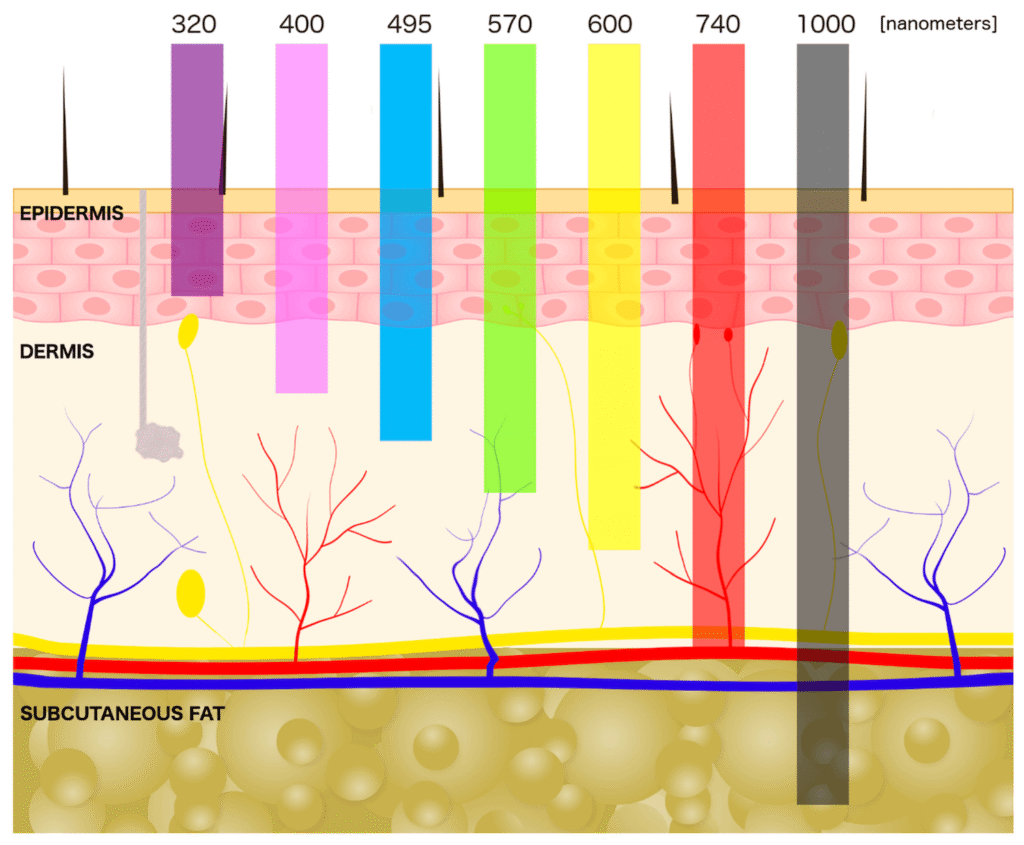impact-Site-Verification: 644d40bf-d31d-408e-8d85-73b41722cbee
Welcome back, RLT newbies! In Part 1, we learned why light is your body’s best friend, powering up cells with red and near-infrared wavelengths. Now, let’s dive deeper into what red light therapy is and how science harnesses these waves to boost your health. From skin glow to pain relief, red light therapy benefits are backed by decades of research. In this post, we’ll unpack RLT’s science (hello, photobiomodulation!), explore how wavelengths work, and explain a cool concept called hormesis. Ready to geek out on how red light therapy works? Let’s get glowing!
RLT Unveiled: More Than Just Red Light
You might call it red light therapy (RLT), but its scientific name—photobiomodulation—is the key to unlocking real research. Want to dig deeper? Skip “red light therapy” on Google (too many ads!) and search “photobiomodulation” on PubMed.gov for legit studies (2025). RLT uses red (600-700 nm) and near-infrared (790-1200 nm) light to spark cellular magic, but don’t let the name fool you—red’s not the only star.
Why “red” then? Most devices combine red and near-infrared, but near-infrared (NIR) is invisible, so the red glow steals the show. Other wavelengths, like blue (400-500 nm), play a role too. For example, blue zaps acne-causing bacteria with reactive oxygen, making it a hero for blue light therapy for acne. But red and NIR are the heavy hitters for healing, and we’ll focus on them here.
RLT’s power lies in its ability to mimic sunlight’s best bits without UV damage. Clinics, sports teams, NASA, and even vets use it for everything from arthritis to wound repair. Let’s see how wavelengths make it happen!
Wavelengths: The Key to Penetration
Ever wonder why red light helps your skin while near-infrared soothes your joints? It’s all about red light therapy penetration depth. Wavelengths—measured in nanometers (nm), a billionth of a meter—decide how deeply light dives into your body. Each wavelength has a “chromophore” (a fancy word for what absorbs it), like melanin, haemoglobin, or water, which affects penetration.
Here’s the breakdown:
- Blue Light (400-500 nm): Stays shallow because melanin (in your skin’s top layer) soaks it up. Great for acne but not deep fixes—think blue light therapy for skin conditions.
- Red Light (600-700 nm): Slips past melanin, hitting haemoglobin in blood just under the skin. It reaches ~1-2 cm, perfect for red light therapy for skin health, like wrinkles or scars (2023).
- Near-Infrared (790-1200 nm): Dodges melanin and blood, diving up to 4 cm to reach muscles, joints, or your brain. Ideal for red light therapy for arthritis relief or red light therapy for brain health.

Think of wavelengths like keys: blue unlocks surface perks, red opens skin benefits, and NIR tackles deeper issues. Devices combine 660 nm (red) and 850 nm (NIR) for versatility—your cells love the combo! A 2022 study found 660 nm boosts collagen, while 850 nm cuts inflammation.
Hormesis: Stress That Strengthens Your Cells
Now, let’s talk red light therapy hormesis—a science gem that makes RLT so powerful. Hormesis is when a mild stressor (like light) nudges your cells to get stronger, like a mini-workout. It’s not just light exercise, saunas, cold plunges, and fasting, do it too. Imagine running a marathon without training: ouch! But jog a mile daily, and your body adapts, building resilience. RLT works the same way.
When red or NIR light hits your cells, it creates a gentle “stress” by sparking ATP production and free radicals. This triggers a chain reaction:
- Anti-Inflammatory Defence: Reduces C-reactive protein, easing arthritis pain.
- Antioxidant Boost: Protects cells from damage, slowing ageing.
- Cell Longevity: Strengthens mitochondria, making cells tougher (2020).
Studies show hormesis from RLT (e.g., 5-10 J/cm² doses) improves skin elasticity and joint mobility in weeks. Saunas (far-infrared, 1200+ nm) and cold plunges mirror this—20-year studies link them to longevity. For RLT, start with 10-minute sessions to build that cellular grit without overdoing it.
Recommended Devices (Amazon USA/UK).
- Red Light Therapy Panel:
- Why: 660 nm/850 nm for skin and deep tissue hormesis. High irradiance (~100 mW/cm²) for quick dosing.
- Image: Panel glowing red (Freepik, “red light therapy panel”).
- Links: Shop Rouge Nano on Amazon USA (#) | Shop GembaRed on Amazon UK (#) (search for latest price).
- Caption: “Boost cells with this red light therapy panel for home use—check the price!”
- Red Light Therapy Belt:
- Why: 660 nm/880 nm, hands-free for arthritis hormesis. ~25 mW/cm² for 15-minute sessions.
- Image: Belt on a knee (Freepik, “red light therapy belt”).
- Links: Shop PEEWF on Amazon USA (#) | Shop Yuehuamech on Amazon UK (#) (search for latest price).
- Caption: “Ease pain with this red light therapy belt—check the price!”
Alt Text: “Red light therapy device for health benefits” (both).
Why RLT’s Science Rocks
From acne-busting blue to joint-soothing NIR, red light therapy benefits come from wavelengths and hormesis working together. Red (600-700 nm) revs up your skin, NIR (790-1200 nm) dives deep, and gentle stress makes your cells tougher. It’s like sunlight’s best hits, minus the burn, brought to your home with devices like panels or belts. Curious? Check PubMed for photobiomodulation studies, or explore our RLT Benefits or RLT Dosing categories for more!
Visuals:
- Penetration Depth Diagram (Freepik, search “light therapy penetration”): Shows blue, red, NIR depths. Alt Text: “Red light therapy penetration depth for skin and joints.”
- Hormesis Infographic (Freepik, search “stress response chart”): Graphs mild vs. intense stress. Alt Text: “Red light therapy hormesis for cell resilience.”






